Target-Aware Feature Bottleneck for Real-Time Visual Tracking
Abstract
:1. Introduction
- In contrast to previous lightweight tracker design approaches where only backbone feature extractors are compressed without consideration of prediction heads, or require a specialized network structure for an architecture search, our feature bottleneck approach is more versatile in terms of backbone network selection and can reduce the computation of prediction heads.
- Under evaluation, we obtain comparable tracking accuracy metrics on multiple benchmarks for visual tracking, LaSOT and GOT-10k, using lighter backbone feature extractors, compared to the other heavier ResNet backbones used in [29].
- Owing to our proposed feature bottleneck module, we accomplish a real-time processing speed of 74 fps which is substantially faster than the sub-real-time speeds of previous global search-based, computationally heavier visual tracking algorithms.
2. Related Work
3. Proposed Method
3.1. Overview of the Baseline Tracking Algorithm
3.2. Incorporation of the Target-Aware Feature Bottleneck Module
| Algorithm 1 Visual tracking with target-aware feature bottleneck |
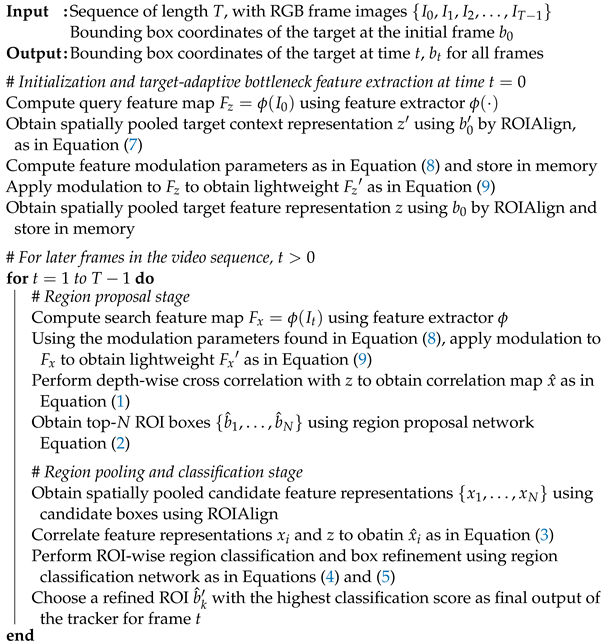 |
3.3. Training the Proposed Framework
3.4. Implementation Details
4. Experiments
4.1. Experimental Settings
4.2. Quantitative Evaluation
Ablation Study
4.3. Qualitative Evaluations and Analysis
5. Conclusions
Funding
Institutional Review Board Statement
Informed Consent Statement
Data Availability Statement
Conflicts of Interest
References
- Fang, S.; Zhang, B.; Hu, J. Improved Mask R-CNN Multi-Target Detection and Segmentation for Autonomous Driving in Complex Scenes. Sensors 2023, 23, 3853. [Google Scholar] [CrossRef] [PubMed]
- Liu, X.; Yang, Y.; Ma, C.; Li, J.; Zhang, S. Real-Time Visual Tracking of Moving Targets Using a Low-Cost Unmanned Aerial Vehicle with a 3-Axis Stabilized Gimbal System. Appl. Sci. 2020, 10, 5064. [Google Scholar] [CrossRef]
- Sun, L.; Chen, J.; Feng, D.; Xing, M. Parallel Ensemble Deep Learning for Real-Time Remote Sensing Video Multi-Target Detection. Remote Sens. 2021, 13, 4377. [Google Scholar] [CrossRef]
- Zhu, J.; Song, Y.; Jiang, N.; Xie, Z.; Fan, C.; Huang, X. Enhanced Doppler Resolution and Sidelobe Suppression Performance for Golay Complementary Waveforms. Remote Sens. 2023, 15, 2452. [Google Scholar] [CrossRef]
- Krizhevsky, A.; Sutskever, I.; Hinton, G.E. ImageNet classification with deep convolutional neural networks. In Proceedings of the NIPS, Lake Tahoe, NV, USA, 3–6 December 2012. [Google Scholar]
- He, K.; Zhang, X.; Ren, S.; Sun, J. Deep residual learning for image recognition. In Proceedings of the CVPR, Las Vegas, NV, USA, 27–30 June 2016. [Google Scholar]
- Ren, S.; He, K.; Girshick, R.; Sun, J. Faster R-CNN: Towards real-time object detection with region proposal networks. In Proceedings of the NIPS, Montreal, QC, Canada, 7–12 December 2015. [Google Scholar]
- Dosovitskiy, A.; Beyer, L.; Kolesnikov, A.; Weissenborn, D.; Zhai, X.; Unterthiner, T.; Dehghani, M.; Minderer, M.; Heigold, G.; Gelly, S.; et al. An Image is Worth 16x16 Words: Transformers for Image Recognition at Scale. In Proceedings of the ICLR, Vienna, Austria, 4 May 2021. [Google Scholar]
- Bertinetto, L.; Valmadre, J.; Henriques, J.F.; Vedaldi, A.; Torr, P.H. Fully-Convolutional Siamese Networks for Object Tracking. arXiv 2016, arXiv:1606.09549. [Google Scholar]
- Li, B.; Wu, W.; Wang, Q.; Zhang, F.; Xing, J.; Yan, J. Siamrpn++: Evolution of siamese visual tracking with very deep networks. In Proceedings of the CVPR, Long Beach, CA, USA, 15–20 June 2019. [Google Scholar]
- Zhang, Z.; Peng, H. Deeper and wider siamese networks for real-time visual tracking. In Proceedings of the CVPR, Long Beach, CA, USA, 15–20 June 2019. [Google Scholar]
- Lin, L.; Fan, H.; Zhang, Z.; Xu, Y.; Ling, H. SwinTrack: A Simple and Strong Baseline for Transformer Tracking. In Proceedings of the NeurIPS, Orleans, LO, USA, 28 November 2022. [Google Scholar]
- Li, B.; Yan, J.; Wu, W.; Zhu, Z.; Hu, X. High Performance Visual Tracking With Siamese Region Proposal Network. In Proceedings of the CVPR, Salt Lake City, UT, USA, 18–23 June 2018. [Google Scholar]
- Zhu, Z.; Wang, Q.; Li, B.; Wu, W.; Yan, J.; Hu, W. Distractor-Aware Siamese Networks for Visual Object Tracking. In Proceedings of the ECCV, Munich, Germany, 8–14 September 2018. [Google Scholar]
- Xu, Y.; Wang, Z.; Li, Z.; Yuan, Y.; Yu, G. SiamFC++: Towards robust and accurate visual tracking with target estimation guidelines. In Proceedings of the AAAI, New York, NY, USA, 7–12 February 2020. [Google Scholar]
- Ma, H.; Acton, S.T.; Lin, Z. CAT: Centerness-Aware Anchor-Free Tracker. Sensors 2022, 22, 354. [Google Scholar] [CrossRef] [PubMed]
- Chen, X.; Yan, B.; Zhu, J.; Wang, D.; Yang, X.; Lu, H. Transformer Tracking. In Proceedings of the CVPR, Virtual, 19–25 June 2021; pp. 8126–8135. [Google Scholar]
- Yan, B.; Peng, H.; Fu, J.; Wang, D.; Lu, H. Learning Spatio-Temporal Transformer for Visual Tracking. In Proceedings of the ICCV, Virtual, 11–17 October 2021; pp. 10448–10457. [Google Scholar]
- Fan, H.; Lin, L.; Yang, F.; Chu, P.; Deng, G.; Yu, S.; Bai, H.; Xu, Y.; Liao, C.; Ling, H. Lasot: A high-quality benchmark for large-scale single object tracking. In Proceedings of the CVPR, Long Beach, CA, USA, 15–20 June 2019. [Google Scholar]
- Huang, L.; Zhao, X.; Huang, K. GOT-10k: A Large High-Diversity Benchmark for Generic Object Tracking in the Wild. IEEE TPAMI 2019, 43, 1562–1577. [Google Scholar] [CrossRef] [PubMed]
- Muller, M.; Bibi, A.; Giancola, S.; Alsubaihi, S.; Ghanem, B. Trackingnet: A large-scale dataset and benchmark for object tracking in the wild. In Proceedings of the ECCV, Munich, Germany, 8–14 September 2018. [Google Scholar]
- Wang, Q.; Zhang, L.; Bertinetto, L.; Hu, W.; Torr, P.H. Fast online object tracking and segmentation: A unifying approach. In Proceedings of the CVPR, Long Beach, CA, USA, 15–20 June 2019. [Google Scholar]
- Hubara, I.; Courbariaux, M.; Soudry, D.; El-Yaniv, R.; Bengio, Y. Binarized Neural Networks. In Proceedings of the NIPS, Barcelona, Spain, 5–10 December 2016; Volume 29. [Google Scholar]
- Han, S.; Pool, J.; Tran, J.; Dally, W. Learning both Weights and Connections for Efficient Neural Network. In Proceedings of the NIPS, Montreal, QC, Canada, 7–12 December 2015. [Google Scholar]
- Han, S.; Mao, H.; Dally, W.J. Deep Compression: Compressing Deep Neural Networks with Pruning, Trained Quantization and Huffman Coding. arXiv 2015, arXiv:1510.00149. [Google Scholar]
- Liu, H.; Simonyan, K.; Yang, Y. DARTS: Differentiable Architecture Search. In Proceedings of the ICLR, New Orleans, LA, USA, 6–9 May 2019. [Google Scholar]
- Wang, G.; Luo, C.; Sun, X.; Xiong, Z.; Zeng, W. Tracking by instance detection: A meta-learning approach. In Proceedings of the CVPR, Seattle, WA, USA, 14–19 June 2020. [Google Scholar]
- Park, E.; Berg, A.C. Meta-tracker: Fast and robust online adaptation for visual object trackers. In Proceedings of the ECCV, Munich, Germany, 8–14 September 2018. [Google Scholar]
- Huang, L.; Zhao, X.; Huang, K. GlobalTrack: A Simple and Strong Baseline for Long-term Tracking. In Proceedings of the AAAI, New York, NY, USA, 7–12 February 2020. [Google Scholar]
- Kalal, Z.; Mikolajczyk, K.; Matas, J. Tracking-learning-detection. IEEE TPAMI 2011, 34, 1409–1422. [Google Scholar] [CrossRef] [PubMed]
- Simonyan, K.; Zisserman, A. Very deep convolutional networks for large-scale image recognition. arXiv 2014, arXiv:1409.1556. [Google Scholar]
- Szegedy, C.; Liu, W.; Jia, Y.; Sermanet, P.; Reed, S.; Anguelov, D.; Erhan, D.; Vanhoucke, V.; Rabinovich, A. Going deeper with convolutions. In Proceedings of the CVPR, Boston, MA, USA, 7–12 June 2015. [Google Scholar]
- Nam, H.; Han, B. Learning Multi-Domain Convolutional Neural Networks for Visual Tracking. In Proceedings of the CVPR, Boston, MA, USA, 7–12 June 2015. [Google Scholar]
- Jung, I.; Son, J.; Baek, M.; Han, B. Real-time mdnet. In Proceedings of the ECCV, Munich, Germany, 8–14 September 2018. [Google Scholar]
- Henriques, J.F.; Caseiro, R.; Martins, P.; Batista, J. High-speed tracking with kernelized correlation filters. IEEE TPAMI 2015, 37, 583–596. [Google Scholar] [CrossRef] [PubMed]
- Ma, C.; Huang, J.B.; Yang, X.; Yang, M.H. Hierarchical convolutional features for visual tracking. In Proceedings of the ICCV, Santiago, Chile, 7–13 December 2015. [Google Scholar]
- Xu, T.; Feng, Z.H.; Wu, X.J.; Kittler, J. Joint group feature selection and discriminative filter learning for robust visual object tracking. In Proceedings of the ICCV, Seoul, Republic of Korea, 27 October–2 November 2019. [Google Scholar]
- Danelljan, M.; Robinson, A.; Khan, F.S.; Felsberg, M. Beyond correlation filters: Learning continuous convolution operators for visual tracking. In Proceedings of the ECCV, Amsterdam, The Netherlands, 11–14 October 2016. [Google Scholar]
- Mueller, M.; Smith, N.; Ghanem, B. Context-aware correlation filter tracking. In Proceedings of the CVPR, Honolulu, HI, USA, 21–26 July 2017. [Google Scholar]
- Valmadre, J.; Bertinetto, L.; Henriques, J.; Vedaldi, A.; Torr, P.H.S. End-To-End Representation Learning for Correlation Filter Based Tracking. In Proceedings of the CVPR, Honolulu, HI, USA, 21–26 July 2017. [Google Scholar]
- Ma, C.; Yang, X.; Zhang, C.; Yang, M.H. Long-term correlation tracking. In Proceedings of the CVPR, Boston, MA, USA, 7–12 June 2015. [Google Scholar]
- Held, D.; Thrun, S.; Savarese, S. Learning to track at 100 fps with deep regression networks. In Proceedings of the ECCV, Amsterdam, The Netherlands, 11–14 October 2016. [Google Scholar]
- Tao, R.; Gavves, E.; Smeulders, A.W. Siamese instance search for tracking. In Proceedings of the CVPR, Las Vegas, NV, USA, 27–30 June 2016. [Google Scholar]
- Zhang, Z.; Peng, H.; Fu, J.; Li, B.; Hu, W. Ocean: Object-aware Anchor-free Tracking. In Proceedings of the ECCV, Glasgow, UK, 23–28 August 2020. [Google Scholar]
- Choi, J.; Kwon, J.; Lee, K.M. Visual Tracking by TridentAlign and Context Embedding. In Proceedings of the ACCV, Kyoto, Japan, 30 November–4 December 2020. [Google Scholar]
- Vaswani, A.; Shazeer, N.; Parmar, N.; Uszkoreit, J.; Jones, L.; Gomez, A.N.; Kaiser, Ł.; Polosukhin, I. Attention is all you need. In Proceedings of the NIPS, Long Beach, CA, USA, 4–9 December 2017. [Google Scholar]
- Wang, X.; Girshick, R.; Gupta, A.; He, K. Non-local neural networks. In Proceedings of the CVPR, Salt Lake City, UT, USA, 18–23 June 2018. [Google Scholar]
- Yang, C.; Zhang, X.; Song, Z. CTT: CNN Meets Transformer for Tracking. Sensors 2022, 22, 3210. [Google Scholar] [CrossRef] [PubMed]
- Yu, B.; Tang, M.; Zheng, L.; Zhu, G.; Wang, J.; Feng, H.; Feng, X.; Lu, H. High-Performance Discriminative Tracking with Transformers. In Proceedings of the ICCV, Virtual, 11–17 October 2021; pp. 9856–9865. [Google Scholar]
- Ye, B.; Chang, H.; Ma, B.; Shan, S.; Chen, X. Joint Feature Learning and Relation Modeling for Tracking: A One-Stream Framework. In Proceedings of the ECCV, Tel Aviv, Israel, 23–27 October 2022. [Google Scholar]
- Liu, Z.; Lin, Y.; Cao, Y.; Hu, H.; Wei, Y.; Zhang, Z.; Lin, S.; Guo, B. Swin Transformer: Hierarchical Vision Transformer using Shifted Windows. In Proceedings of the ICCV, Montreal, QC, Canada, 10–17 October 2021. [Google Scholar]
- Deng, L.; Li, G.; Han, S.; Shi, L.; Xie, Y. Model Compression and Hardware Acceleration for Neural Networks: A Comprehensive Survey. Proc. IEEE 2020, 108, 485–532. [Google Scholar] [CrossRef]
- Yu, X.; Liu, T.; Wang, X.; Tao, D. On Compressing Deep Models by Low Rank and Sparse Decomposition. In Proceedings of the CVPR, Honolulu, HI, USA, 21–26 July 2017. [Google Scholar]
- He, Y.; Lin, J.; Liu, Z.; Wang, H.; Li, L.J.; Han, S. AMC: AutoML for Model Compression and Acceleration on Mobile Devices. In Proceedings of the ECCV, Munich, Germany, 8–14 September 2018. [Google Scholar]
- Sandler, M.; Howard, A.; Zhu, M.; Zhmoginov, A.; Chen, L.C. MobileNetV2: Inverted Residuals and Linear Bottlenecks. In Proceedings of the CVPR, Salt Lake City, UT, USA, 18–23 June 2018. [Google Scholar]
- Cheng, L.; Zheng, X.; Zhao, M.; Dou, R.; Yu, S.; Wu, N.; Liu, L. SiamMixer: A Lightweight and Hardware-Friendly Visual Object-Tracking Network. Sensors 2022, 22, 1585. [Google Scholar] [CrossRef] [PubMed]
- Dong, X.; Shen, J.; Shao, L.; Porikli, F. CLNet: A Compact Latent Network for Fast Adjusting Siamese Trackers. In Proceedings of the ECCV, Glasgow, UK, 23–28 August 2020. [Google Scholar]
- Yan, B.; Peng, H.; Wu, K.; Wang, D.; Fu, J.; Lu, H. LightTrack: Finding Lightweight Neural Networks for Object Tracking via One-Shot Architecture Search. In Proceedings of the CVPR, Nashville, TN, USA, 20–25 June 2021; pp. 15180–15189. [Google Scholar]
- Blatter, P.; Kanakis, M.; Danelljan, M.; Van Gool, L. Efficient Visual Tracking With Exemplar Transformers. In Proceedings of the WACV, Waikoloa, HI, USA, 2–7 January 2023; pp. 1571–1581. [Google Scholar]
- He, K.; Gkioxari, G.; Dollár, P.; Girshick, R. Mask r-cnn. In Proceedings of the ICCV, Venice, Italy, 22–29 October 2017. [Google Scholar]
- Tian, Z.; Shen, C.; Chen, H.; He, T. FCOS: Fully convolutional one-stage object detection. In Proceedings of the ICCV, Seoul, Republic of Korea, 27 October–2 November 2019. [Google Scholar]
- Wu, Y.; He, K. Group normalization. In Proceedings of the ECCV, Munich, Germany, 8–14 September 2018. [Google Scholar]
- Lin, T.Y.; Goyal, P.; Girshick, R.; He, K.; Dollár, P. Focal loss for dense object detection. In Proceedings of the ICCV, Venice, Italy, 22–29 October 2017. [Google Scholar]
- Kingma, D.; Ba, J. Adam: A method for stochastic optimization. arXiv 2014, arXiv:1412.6980. [Google Scholar]
- Russakovsky, O.; Deng, J.; Su, H.; Krause, J.; Satheesh, S.; Ma, S.; Huang, Z.; Karpathy, A.; Khosla, A.; Bernstein, M.; et al. Imagenet large scale visual recognition challenge. IJCV 2015, 115, 211–252. [Google Scholar] [CrossRef]
- Real, E.; Shlens, J.; Mazzocchi, S.; Pan, X.; Vanhoucke, V. Youtube-boundingboxes: A large high-precision human-annotated data set for object detection in video. In Proceedings of the CVPR, Honolulu, HI, USA, 21–26 July 2017. [Google Scholar]
- Paszke, A.; Gross, S.; Massa, F.; Lerer, A.; Bradbury, J.; Chanan, G.; Killeen, T.; Lin, Z.; Gimelshein, N.; Antiga, L.; et al. Pytorch: An imperative style, high-performance deep learning library. In Proceedings of the NeurIPS, Vancouver, CA, USA, 8–14 December 2019. [Google Scholar]
- Danelljan, M.; Bhat, G.; Khan, F.S.; Felsberg, M. Atom: Accurate tracking by overlap maximization. In Proceedings of the CVPR, Long Beach, CA, USA, 15–20 June 2019. [Google Scholar]
- Yan, B.; Zhao, H.; Wang, D.; Lu, H.; Yang, X. ’Skimming-Perusal’Tracking: A Framework for Real-Time and Robust Long-term Tracking. In Proceedings of the ICCV, Seoul, Republic of Korea, 27 October–2 November 2019. [Google Scholar]
- Bhat, G.; Danelljan, M.; Gool, L.V.; Timofte, R. Learning discriminative model prediction for tracking. In Proceedings of the ICCV, Seoul, Republic of Korea, 27 October–2 November 2019. [Google Scholar]
- Zhang, Z.; Liu, Y.; Wang, X.; Li, B.; Hu, W. Learn To Match: Automatic Matching Network Design for Visual Tracking. In Proceedings of the ICCV, Virtual, 11–17 October 2021; pp. 13339–13348. [Google Scholar]
- Liu, L.; Long, Y.; Li, G.; Nie, T.; Zhang, C.; He, B. Fast and Accurate Visual Tracking with Group Convolution and Pixel-Level Correlation. Appl. Sci. 2023, 13, 9746. [Google Scholar] [CrossRef]
- Deng, A.; Liu, J.; Chen, Q.; Wang, X.; Zuo, Y. Visual Tracking with FPN Based on Transformer and Response Map Enhancement. Appl. Sci. 2022, 12, 6551. [Google Scholar] [CrossRef]
- Danelljan, M.; Bhat, G.; Khan, F.; Felsberg, M. ECO: Efficient Convolution Operators for Tracking. In Proceedings of the CVPR, Honolulu, HI, USA, 21–26 July 2017. [Google Scholar]
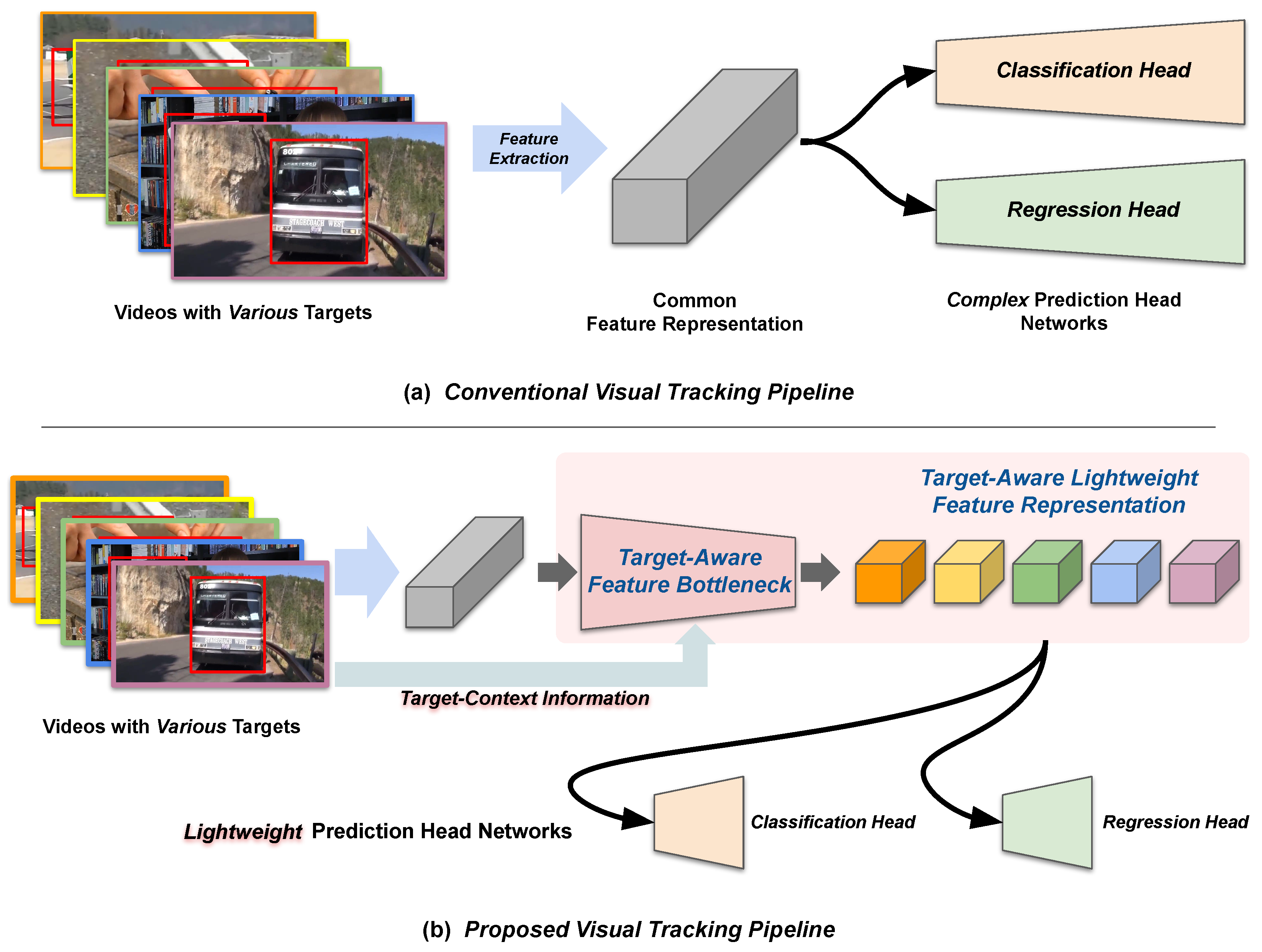
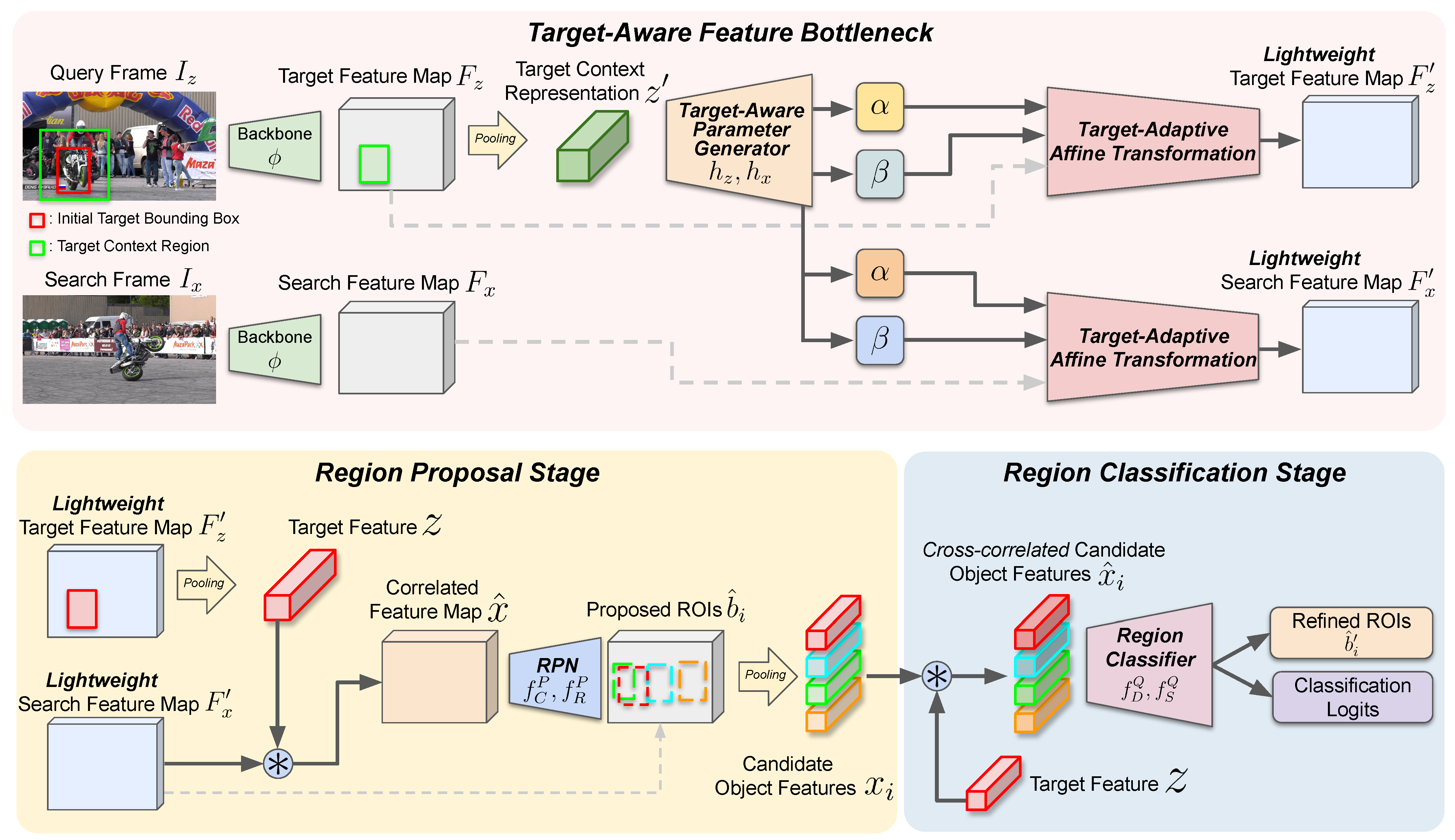
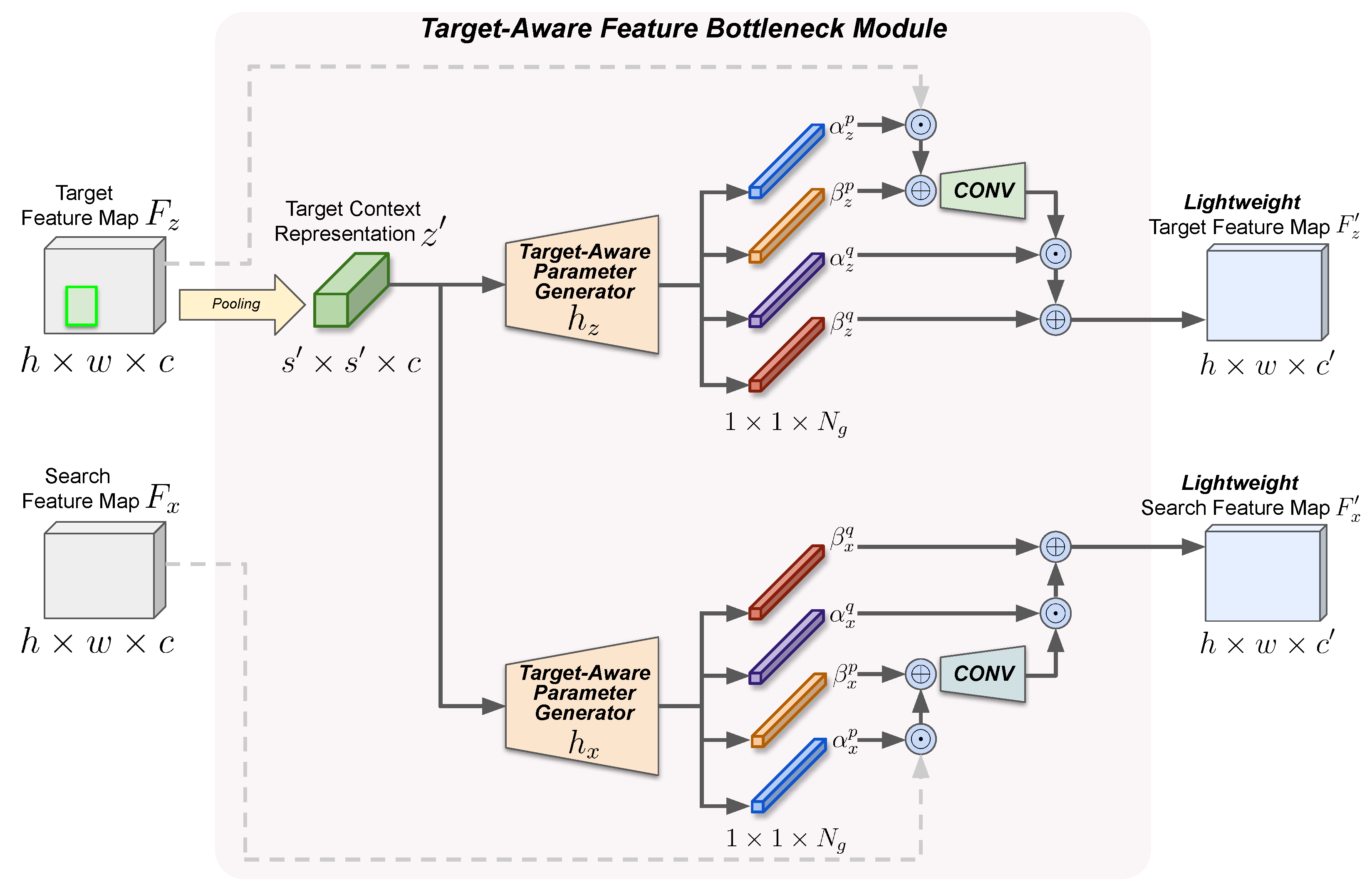

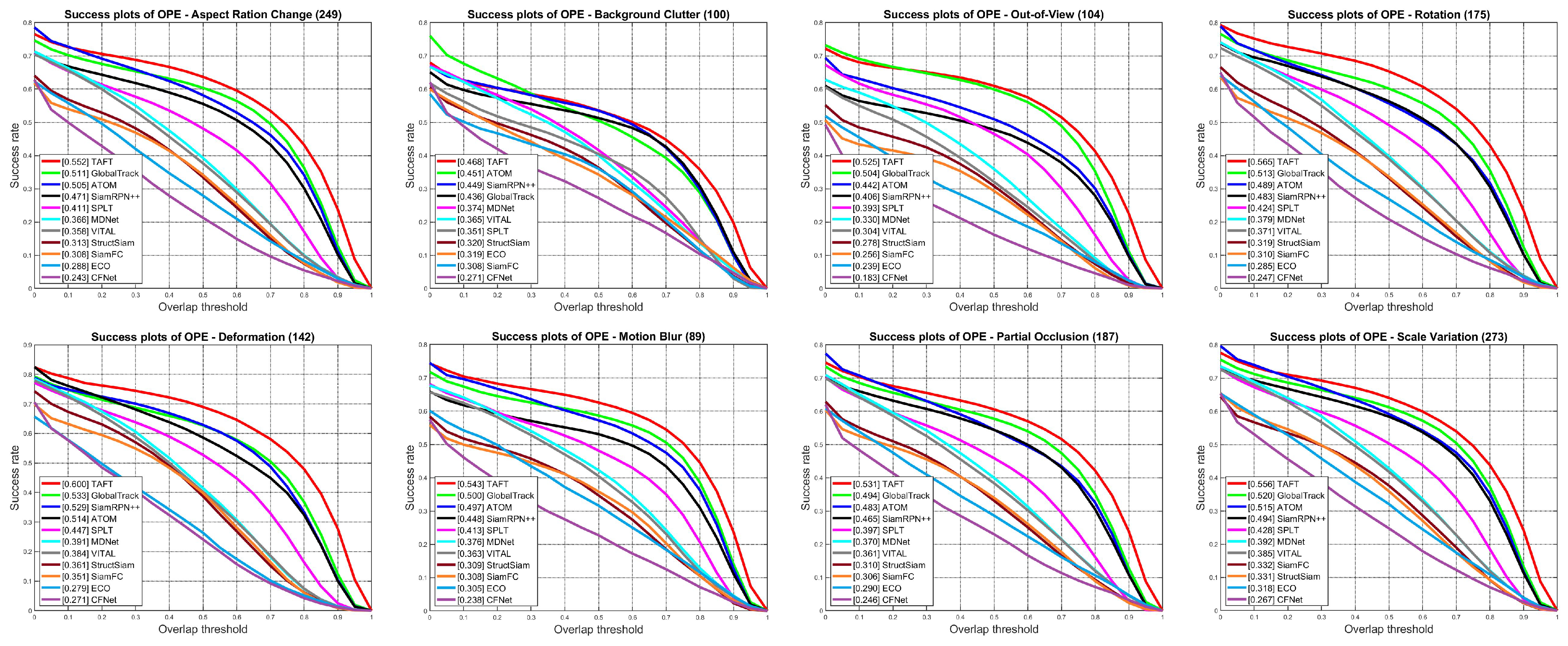
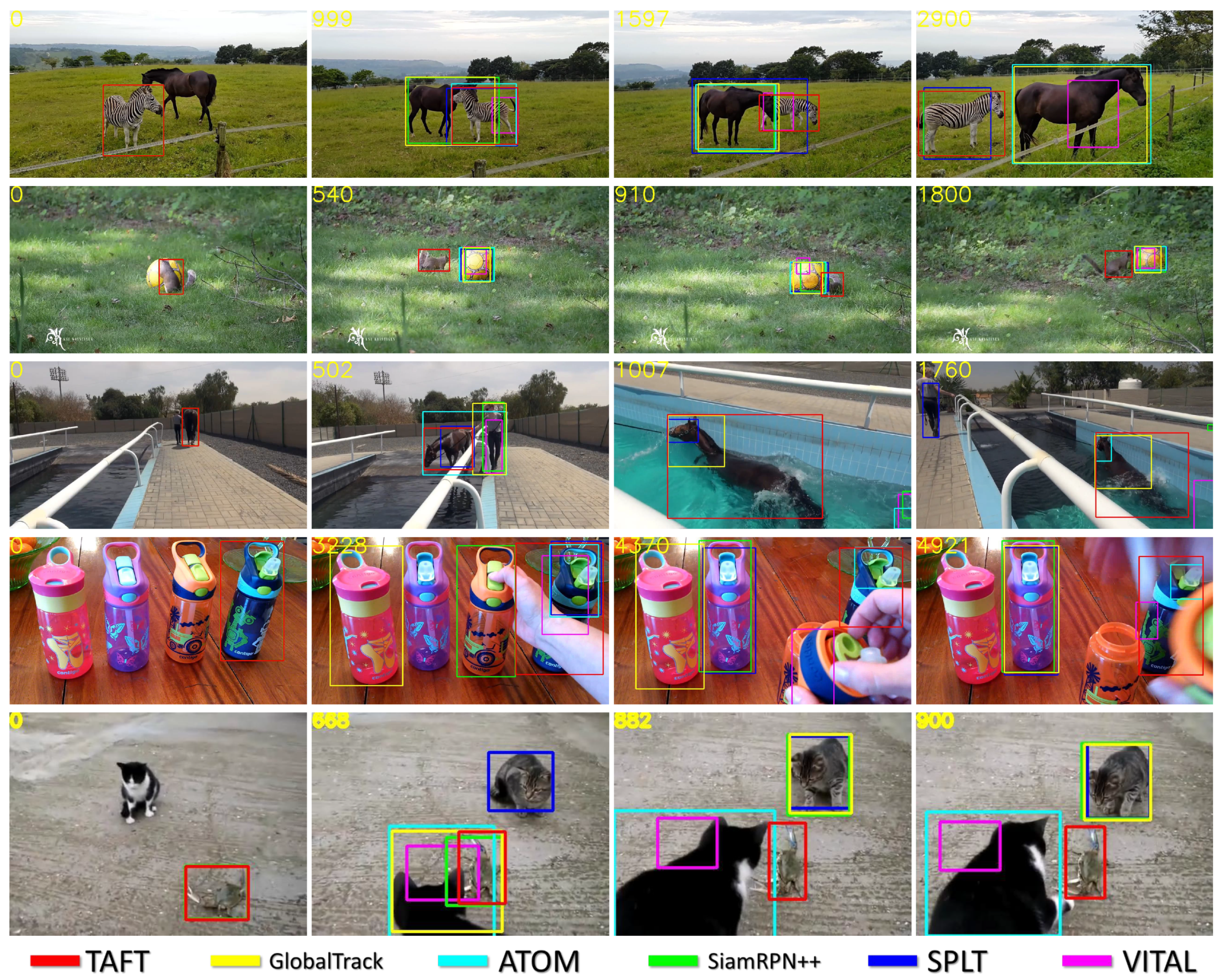
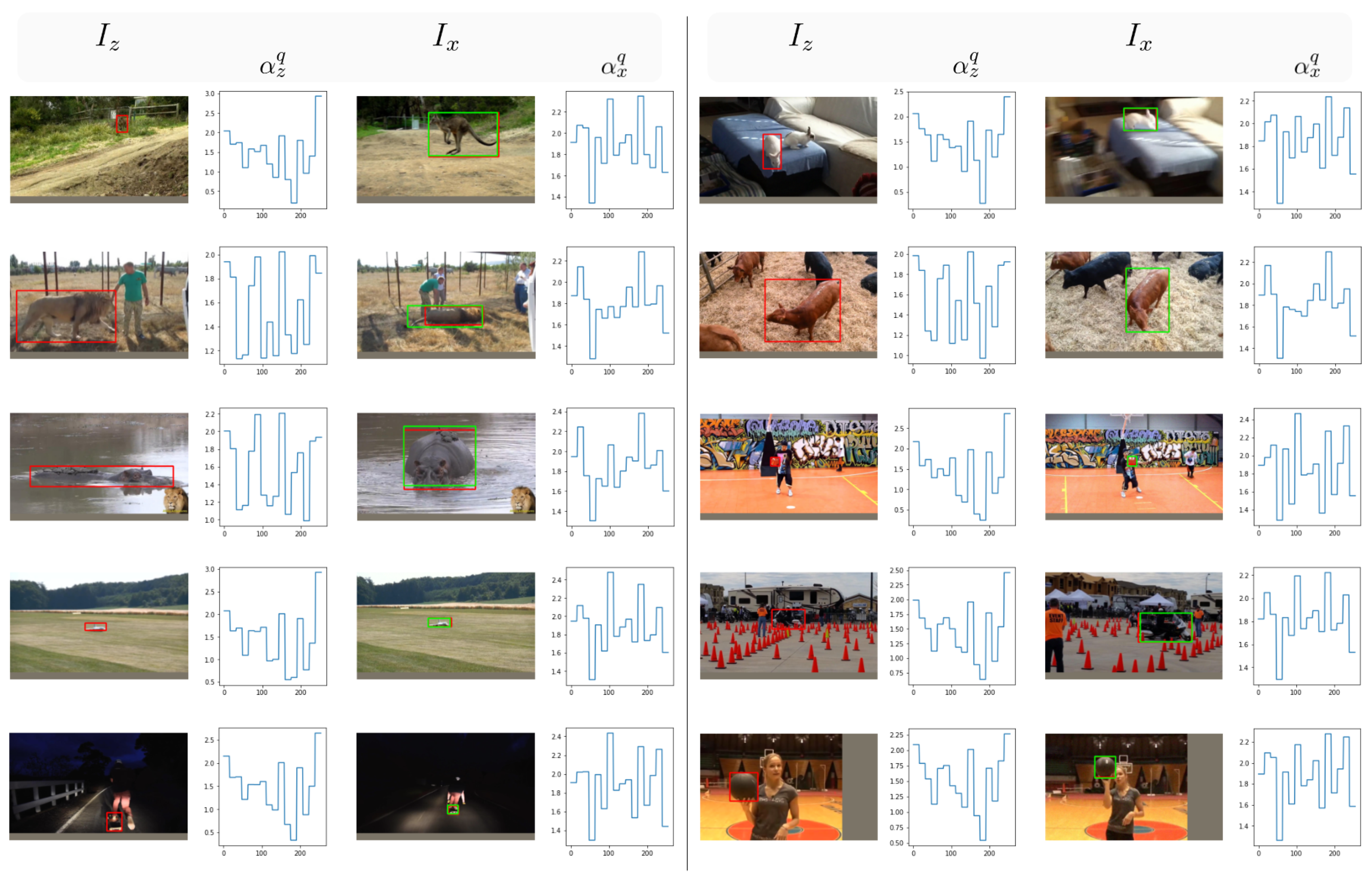
| TAFT | GlobalTrack [29] | DiMP-50 [70] | ATOM [68] | DASiam [14] | SiamRPN++ [10] | MDNet [33] | SPLT [69] | Ocean [44] | CFNet [40] | SiamFC [9] | AutoMatch [71] | MCAGSA [72] | TFN [73] | |
|---|---|---|---|---|---|---|---|---|---|---|---|---|---|---|
| AUC | 0.555 | 0.521 | 0.569 | 0.518 | 0.448 | 0.496 | 0.397 | 0.426 | 0.560 | 0.275 | 0.336 | 0.583 | 0.572 | 0.528 |
| Precision | 0.576 | 0.529 | - | 0.506 | 0.427 | 0.491 | 0.373 | 0.396 | 0.566 | 0.259 | 0.339 | 0.599 | - | 0.527 |
| Norm. Prec. | 0.614 | 0.599 | 0.650 | 0.576 | - | 0.569 | 0.460 | 0.494 | - | 0.312 | 0.420 | - | - | 0.606 |
| FPS | 74 | 6 | 43 | 30 | 110 | 35 | 0.9 | 25.7 | 25 | 43 | 58 | 50 | 40 | 45 |
| (%) | TAFT | DiMP-50 [70] | ATOM [68] | SiamMask [22] | Ocean [44] | CFNet [40] | GOTURN [42] | SiamFC [9] | CCOT [38] | ECO [74] | CF2 [36] | MDNet [33] | TFN [73] |
|---|---|---|---|---|---|---|---|---|---|---|---|---|---|
| 65.2 | 71.7 | 63.4 | 58.7 | 72.1 | 40.4 | 37.5 | 35.3 | 32.8 | 30.9 | 29.7 | 30.3 | 0.683 | |
| 50.6 | 49.2 | 40.2 | 36.6 | - | 14.4 | 12.4 | 9.8 | 10.7 | 11.1 | 8.8 | 9.9 | 0.457 | |
| 57.5 | 61.1 | 55.6 | 51.4 | 61.1 | 37.4 | 34.7 | 34.8 | 32.5 | 31.6 | 31.5 | 29.9 | 0.582 |
| Setting | AUC | |||
|---|---|---|---|---|
| (1) | 256 | 16 | 1/2 | 0.555 |
| (2) | 256 | 8 | 1/2 | 0.549 |
| (3) | 128 | 16 | 1/4 | 0.546 |
| (4) | 128 | 4 | 1/4 | 0.538 |
| (5) | 64 | 32 | 1/8 | 0.543 |
| (6) | 64 | 4 | 1/8 | 0.519 |
| (7) | 256 | - | 1/2 | 0.532 |
Disclaimer/Publisher’s Note: The statements, opinions and data contained in all publications are solely those of the individual author(s) and contributor(s) and not of MDPI and/or the editor(s). MDPI and/or the editor(s) disclaim responsibility for any injury to people or property resulting from any ideas, methods, instructions or products referred to in the content. |
© 2023 by the author. Licensee MDPI, Basel, Switzerland. This article is an open access article distributed under the terms and conditions of the Creative Commons Attribution (CC BY) license (https://creativecommons.org/licenses/by/4.0/).
Share and Cite
Choi, J. Target-Aware Feature Bottleneck for Real-Time Visual Tracking. Appl. Sci. 2023, 13, 10198. https://doi.org/10.3390/app131810198
Choi J. Target-Aware Feature Bottleneck for Real-Time Visual Tracking. Applied Sciences. 2023; 13(18):10198. https://doi.org/10.3390/app131810198
Chicago/Turabian StyleChoi, Janghoon. 2023. "Target-Aware Feature Bottleneck for Real-Time Visual Tracking" Applied Sciences 13, no. 18: 10198. https://doi.org/10.3390/app131810198
APA StyleChoi, J. (2023). Target-Aware Feature Bottleneck for Real-Time Visual Tracking. Applied Sciences, 13(18), 10198. https://doi.org/10.3390/app131810198







